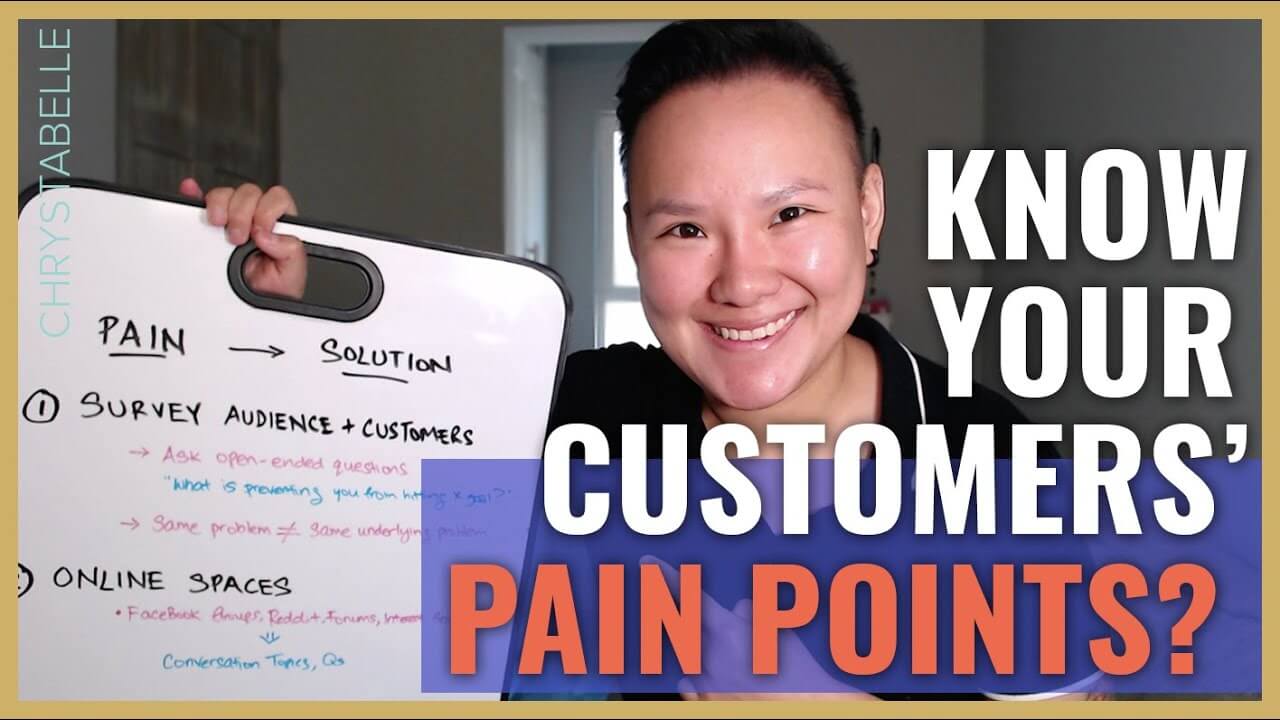Hey guys in this video I’m gonna walk you through one of the fundamentals of marketing and running an online business. I’m gonna walk you through how to identify your customer’s pain points, as well as how I identify my customer’s pain point so that you can go replicate the process by the end of this video. Now the reason why this is so important for you to understand is that when you understand your customer’s pain points, you understand the challenges and the pains that they go through, now you can start to position your product your offer your product or service as the solution to their problem, to the pain points.
And so this is why this is so fundamental, every online entrepreneur needs to understand the customer’s pain points. So I’m gonna walk you through the process that I used to identify my customer’s pain points.
So the first step in my process is surveying my existing audience and my existing customers and past customers. What I’m trying to figure out from them is to ask them questions about what are their biggest challenges, what are their pain points. So what I want to do is to ask open-ended questions, things like what is the biggest challenge right now that is stopping you from achieving X? For example.
What is your biggest pain point when it comes to getting sales?
For example. So one of the things I recently did was to send out an email to my email list and I asked them, can I get you to answer a quick 30-second survey, one minute survey, a couple of questions just to kind of find out more about where you’re at right now and how I can help you. I phrase it in a way where if I can understand their biggest challenges, I can create products and services, and content that would answer our biggest challenges. So I’m coming from a point where I’m trying to help them to achieve that solution.
So what I want you to remember is that even though a lot of them might have the same problem, so for example, I’m struggling to get sales.
They might have the same problem but they might not have the same underlying problem. So what I mean by that is a lot of them might say oh I’m struggling with getting sales. Now for some of them, it might be because they are not getting enough leads, so they have an issue with lead generation. Now for other people, it might be because they have got money mindset problems, so their mindset is stopping them from getting enough sales and getting more sales. And so what we want to do as you survey your audience, as you survey your customers, is that you want to dive deeper into what they’re just telling you.
So you want to ask open-ended questions that don’t just give you yes or no answers, and you want to dive deeper.
You want to ask them, why? You want to kind of figure out what’s the underlying prom because like I said they all have different underlying problems. People don’t get sales, not all because they don’t have enough leads. Some people don’t get sales because they’re not selling enough, they’re not promoting enough, they’re afraid of selling, they have money mindset issues, they don’t have enough leads so on and so forth.
So you want to figure out what is the underlying problem. Now, what if you don’t have an existing audience or customers to tap into? This is where you can jump right into step number two, the online spaces. Now the second step in my process is I go online and I try to find online spaces where I know my potential customers are hanging out.
So online spaces such as Facebook groups.
Facebook groups are great when it comes to trying to identify your customer’s pain points. There are Facebook groups for everything under the sun. Everything from entrepreneurship to sports and fitness to mummy Facebook groups to food Facebook groups to hobbies Facebook groups. There are Facebook groups on anything. So what I like to do is I like to join certain Facebook groups where I know my ideal paying customers, who are online entrepreneurs, are hanging out in.
Other online spaces that I would join would be Reddit so Reddit forums. Online forums, niche websites, specific interest groups. So this is great if you’re starting out, you’ve got no audience, you’ve got no list to tap into, no customers to tap into and yet you need to understand what your ideal paying customers are facing the challenges, the pain points they are facing. So once you’re in these Facebook groups and these online spaces, what you’re trying to do is you’re trying to pay attention to the conversations that you’re having. You want to observe what questions are they asking about, what some of the pain points that they’re expressing about, what are some of the common threads that you’re seeing, the common things that you’re seeing because they’ll really help you to identify what are some of the pain points they’re going through even though these people are not part of your audience yet.
And then the third thing in my process that I like to do is to use research tools. Research tools that help me to really understand what are my ideal paying customers, what are my customers are searching for online.
Because a lot of times when people face problems and issues, the first thing you do is to go onto Google and try to Google an answer to their problems, to your challenges, to your pain points. So what I want to do is to use one of these tools to understand what are they searching for. And one of the tools that I highly recommend that you check out, it’s free, it’s great for those of you who are starting out, it’s called Answer The Public.
I probably mentioned this a couple of times before in my videos, but this tool is what I used to really understand them. So what it does really is you enter a keyword, for example, fitness equipment.
You enter a keyword into Answer The Public and then it starts to churn out all the common questions and all the common search terms and search phrases relate it to that keyword things, like what fitness equipment do I buy, which fitness equipment is great for weight loss. So it churns out all the common phrases and the common search terms based on what where how can which so on and so forth. It is especially great to really understand what are people searching for in relation to what you’re selling, the problems that they are trying to solve when they’re searching for something online on Google.
And then the fourth step in my process to really try to understand and identify my customer’s pain points is step number four – public reviews.
And so what I’m trying to do here is I would go on to eCommerce sites like Amazon for example and I would search for, back to the example of the fitness equipment, I would search for the top-selling fitness equipment out there. And I would look through the reviews that are being left by my ideal paying customers and I would try to understand what are they commenting about. What do they like about those top-selling fitness equipment? What do they not like about the top-selling fitness equipment?
What’s missing from this fitness equipment? So then I can understand what are the pain points. Another thing I do is I go onto content sites or content sites like YouTube for example. So I would search for YouTube videos related to fitness equipment and fitness in general and I would read through the comments that people leave on these top YouTube videos about fitness equipment and I will see and I read through the comments that they leave behind, so that I can really understand what are some of the questions that they’re asking the content creator about fitness equipment and fitness in general.
So those are the four things that I do in my process.
Now once I understand and I’ve identified my customer’s pain points, what do I do next? The next thing I want to do is to make sure that these pain points that I’ve identified are pain points that are big enough or painful enough that my ideal paying customers will pay for a solution. A mistake that I see a lot of entrepreneurs make is they identify certain pain points and they create a product or a service around those pain points. But people don’t buy because those pain points are not painful enough for people to actually pay for them.
So we got to make sure that the pain points that we select, have be painful enough to motivate your ideal paying customer to exchange the money for a solution.
Now once you’ve identified the most painful pain points and the most painful challenges that they will pay for, what we want to do is to move on to and start using those pain points in our marketing. So right here we want to start using all these pain points that we’ve identified in our marketing.
And there are three things that we got to do when we’re using pain points in our marketing. Now the first thing I want to do is to tailor and parrot. I’m not sure if you can see this but tailor and parrot the words the prompt the phrases that they, your idea paying customers are using, in your marketing.
So for example if they’re saying that I’m really tired from trying to manage my household and trying to keep everything clean. And in your marketing, you want to parrot what they’re saying. So you want to say if you’re tired of trying to manage your household and keep everything clean…
do you see what I mean? Your ideal paying customers when they see that the words that they’re using on a daily basis, the prompts, the phrases that they use are being parroted back to them, feel this connection with your marketing messaging. They feel like you understand them better than all the other brands out there who are trying to market to them.
So we want to make sure that we are tailoring and parroting what they’re saying. Now step number two is we want to make sure that you use the same terminology that they’re using.
So what I mean by using the same words and terminology basically means is you don’t want to sound too technical or too industry-specific – the words you use in your industry. In your messaging and your marketing messaging, you want to use the words that they are using, again back to number one right? You want to use the same words and same terms that they’re using. It builds trust. So when I’m trying to market, for example, No-Sweat Sales Workbook And Scripts, I’m not trying to say, increase your ROI with the No-Sweat Sales Workbook And Scripts.
I just say, learn how to get sales without feeling frustrated or feeling slimy. These are words that people commonly used when they’re trying to describe sales… like oh it’s frustrating it’s slimy, it’s salesy.
So I use those words and terminology in my marketing messaging. Now the third thing that you want to do is to emphasize transformation. Above everything else, I think this is probably one of the most important things that you got to do in your marketing as you’re trying to mention your customer’s pain points. People don’t buy a product or service. They buy a transformation.
A transformation in status, a transformation in health, a transformation in financial status right now. They buy a perceived transformation. And so in our marketing messaging, once you understand the pain points that your customers are going through and you select those pain points that you want to focus on, you want to emphasize the transformation of buying and using your product or your service. So back to the fitness equipment example. Say you’re selling fitness equipment.
Now instead of just saying this fitness equipment comes in in two colors, it’s this big, this long, it helps you to build muscles, helps you to lose weight.
Now what you want to talk about in the transformation is to share what their life would be like when they lose that weight, when they start to develop those muscles right. Speak to the aspiration of what they’re trying to achieve. So imagine entering the store and picking up your favorite blouse and now being able to fit it into your blouse because you’ve been using this equipment for the past 12 weeks.
Imagine how would that feel when you put on this blouse.
You want to try to speak to that transformation, to that aspiration and they’re aiming for. You don’t just want to tell them the features of that product or that service that you’re trying to sell. So guys I hope you found that useful and helping you understand how to identify your customer’s pain points. Let me know in the comments below if you’ve got any follow-up questions about identifying your customer’s pain points. Take the process that I walked you through, replicate it for your own online business.
Now if you found this video useful don’t forget to hit the like button so that I know you liked the video and you found it useful. And also if you’re not already subscribed to the channel go ahead and hit the subscribe button. Now in the meantime, there’s a wait for my next video, don’t forget to go check out this video to learn more about online marketing online business. Alright, thanks for watching I’ll catch your next video…








